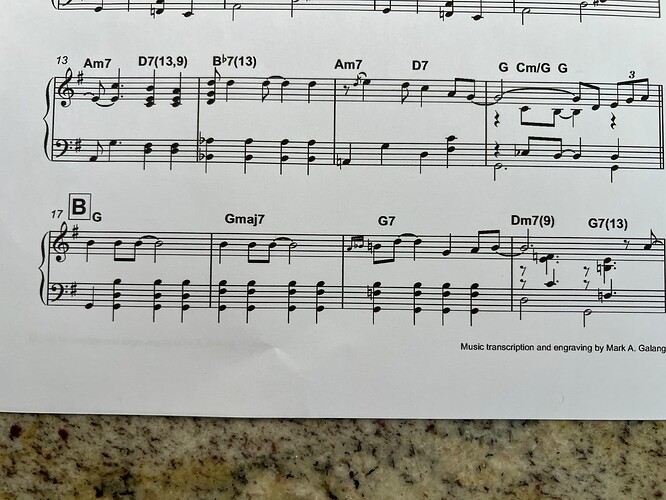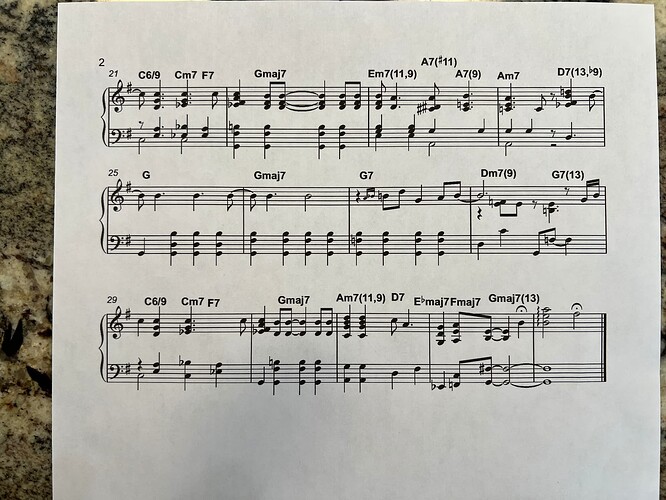I came across a couple of songs that obviously have been rehamonized on MusicNotes. There are a few reharmonization that just don’t make sense. In short, I am looking for a resource that could help when one encounters these events. I can analyse the piece (i.e., VII of on in the key of A), but can’t make it fit into reharmonization topic or course on PIANOGROOVE. My belief is that it would be a valuable learning or teaching tool. John Lander
Hey @landermaestro
If you’d like to share a screenshot of the section of music that you are working on, I can explain how and why the reharmonisations are being used. Please feel free to share multiple examples if you like, and I will analyse them all for you. Just post them below in this thread.
Often there will be a ’ V → I ’ relationship used in a reharmonisation, whether that’s the regular V chord, the tritone substitute, or something more sophisticated.
Other times, a reharmonisation can be chosen simply because the new chord supports the melody note.
Take a screenshot of the music you’re working on, and drag it into the forum message window and it will automatically upload it so that we can analyse it together. Looking forward!
Hey @landermaestro
If you’d like to share a screenshot of the section of music that you are working on, I can explain how and why the reharmonisations are being used and what is the underlying theory. Please feel free to share multiple examples if you like, and I will analyse them all for you. Just post them below in this thread.
Often there will be a ’ V → I ’ relationship used in a reharmonisation, whether that’s the regular V chord, the tritone substitute, or something more sophisticated.
Other times, a reharmonisation can be chosen simply because the new chord supports the melody note.
Take a screenshot of the music you’re working on, and ‘drag and drop’ the screenshot into the forum message window and it will automatically upload it so that we can analyse it together.
Hey @landermaestro
Thanks for sharing the notation. I will record a video for you tomorrow explaining these reharmonisations in detail as it’s a tune I’m familiar with.
To give you some quick explanations now:
The F6 in bars 1 and 3 could be seen as a passing chord which creates additional bass movement between the tonic Gmaj7, and the VI7 chord E7. The core progression here is a 1625 (Gmaj7 → E7alt → A-7 → D7) and so I would just look at the F6 as an additional ‘stepping stone’ that happens to work well with the melody note (A) and also connects the bass notes of the 1 and 6 chord via the step-wise/chromatic bass line.
Remember that sometimes a reharmonisation can be justified simply because it supports the melody note. There does not need to be a harmonic connection/relationship; it’s nice if there is one, but sometimes reharms can sound amazing when there is no strong harmonic relationship at play.
For the Ab7 in bar 4 - I would actually play a Bb9#11 here instead - as this works better with the melody note, in my opinion at least. I use this kind of reharmonisation a lot, where the melody note is simply harmonised as a dominant chord with the #11 in the melody (E natural is the #11 of Bb7).
We could also see the Ab7#11 as a dominant passing chord. Dominant passing chords can be used to approach a chord a half step below (regular tritone sub), or in this case a half step above (Ab7 to A-7) - which also works.
In bars 4 and 5, we have A-7, Ab7, and A-7 and so we could see that Ab7 as a chord that is ‘close by’ geographically and used to add some tension into what would otherwise be static harmony.
To reiterate, I do prefer Bb9#11 here which also create creates the half step resolution from above into the A-7 chord in bar 5.
The Bb7 in bar 6 is a tritone substitution for E7. We have Bm7 (the iii-7 in the key of G Major) which would go to E7 (the VI7 in G Major), to A-7 (the ii-7 chord in G Major), and instead the Bb7 is used as the tritone of the E7.
I will share some more findings and demonstrations in a video tomorrow.
Thanks…the explanation is helpful and I look forward to you video…can’t thank you enough. John


